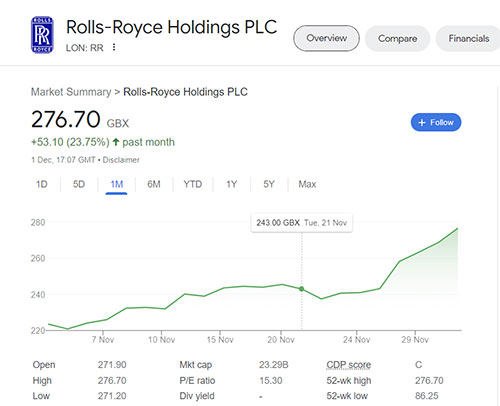
A version of this article first appeared in our free newsletter, to subscribe click here.
Rolls Royce have announced that they are going to exit the AAM arena (https://www.flightglobal.com/aerospace/rolls-royce-pulls-plug-on-electric-propulsion-plans/156006.article)
Rolls Royce acquired their aircraft electric motor business from Siemens for an undisclosed sum in 2019: (https://press.siemens.com/global/en/pressrelease/siemens-sells-electric-aircraft-propulsion-business-rolls-royce). This is the end of both Rolls Royce and Siemens involvement in developing electric powertrain for aircraft.
What does this mean? As Rolls Royce is a business and we can assume that they run their business on a rational basis, they have assessed that the risk vs reward balance is negative.
It is negative to such an extent that they are willing to write off the purchase of the business from Siemens and the money that they have invested since the acquisition.
How did the markets react over the last 4 days?

It is early days yet but I would say that in the short term the markets agree.
The advice I have received from within eVTOL startups from the most competent people I know is that you have to develop all of these new technologies in-house.
This is what Pipstrel did with the Velis powertrain and it was the right thing to do.
This is what Boom Supersonic have had to do after Rolls Royce pulled out of the Symphony program. (https://www.aviationpros.com/aircraft/commercial-airline/news/21280988/boom-supersonic-loses-engine-manufacturer-what-that-means-for-the-jet-maker)
I am not saying Rolls Royce is particularly bad, but they clearly have a risk tolerance lower than other engine manufacturers. Every risky startup assumes that a risk sharing partner is in the program with them for the long term. When you bring in suppliers who are many times your size, they have a level of acceptable risk. That acceptable risk is always lower than yours. They can walk away from the program at any time if their risk assessment changes, or the rest of their business outlook changes.
As a startup with a single product you are in a do or die situation. Every large supplier you bring into the program is not. For them it is less of ‘do or die’, more of ‘yawn, meh, what do the business analysts say?’ situation.
Startup companies developing new technology can share the risk with larger suppliers but they cannot share the risk tolerance.
You can outsource commodity items and services – seats, sheet metal fabrication, interior liners, wheel, tires, etc.
You can never outsource risk, and indeed, you never should. A supplier’s appetite to accept your risk is always going to be a fraction of your own.
You will have to raise the capital and develop the technology in house. Vertically integrate. There is a reason that in the early years of aviation many aircraft OEMs developed their own engines.
Ironically Rolls Royce was one of the first non aircraft manufacturers to make an aircraft engine (https://en.wikipedia.org/wiki/Rolls-Royce_Limited). In 1914 and only at the request of the British government.
There are external suppliers left in the AAM electric powertrain field. How much appetite for risk do they have compared to Rolls Royce? Will they have the appetite for risk to maintain their involvement in this sector? For how long?
One should not conclude that Advanced Air Mobility has no future. But we can conclude that it was a mistake to take on large, risk averse partners as partners on new technology projects.
If you want to develop an aircraft that depends on a new technology, develop the new technology first.

Pipstrel did.
If you design your own motor you will have an easier set of boundary conditions to meet than a larger risk sharing partner who will want the product to meet a wider range of applications to maximize revenue potential.
If I were a eVTOL developer with a risk sharing partner developing the electric powertrain I would be nervous. I would set up an in-house development group, get the best people, give them a difficult mission with a small budget. If Pipistrel did it, you can too.

Comment On This Post